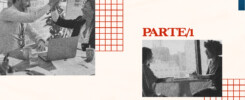
Imagine a traditional classroom scenario: a teacher at the head of the class teaching content and being the source of all knowledge, while the student, a mere spectator of the teaching-learning practice, remains in an upright learning position, performs his tasks and then go away. Now, consider the exact opposite of this whole process: the student as the source of knowledge and the entire teaching-learning process, whether through the student’s starting point (according to Freire’s pedagogy) or the student as the one who develops the contents and teaches them. That’s the future. And this is certainly flipped classroom, but not only…
WHAT IS THE CONCEPT OF FLIPPED CLASSROOM AND WHERE DOES IT COME FROM?
In the active methodology of the Flipped Classroom (or “flipped classroom”), the learning environment becomes different, but it is not only the environment that changes. Initially, this activity takes place when the student starts to have contact with the content even before the classes – a very common method, even, all over the world, especially in the United States and the European Union, but still “shy” in Brazil.
In this method, the student is the one who must carry out consistent research and seek the content that is the object of learning, not the opposite. Whether through academic articles or audiovisual resources, since the tools don’t matter, as long as the final goal is achieved. You must be wondering where the teacher enters in all this and as the classroom environment unfolds, the following happens: the teacher becomes an aid, guide, mentor, helping throughout the process and journey, in which the student is the guide. In classes, the space is used to ask questions and discuss content.
This resource appeared in 2008, by the hands of two North American teachers (Jonathan Bergmann and Aaron Sams) who one day decided to record videos of their classes and make them available on the internet for students who eventually missed their classes. The videos, in a way, “went viral” and began to be accessed by students and teachers from other parts of the United States and the world. Realizing the potential of the work they started, they ended up developing the method and leveraging its use. Today, both are on the board of the Flipped Learning Network (FLN), an institution dedicated to research on the flipped model.

ADVANTAGES OF THE FLIPPED CLASSROOM METHODOLOGY
- Emphasis on the individual process of each student and the development of a unique program that meets the individual needs of each one;
- Development of greater independence and autonomy on the part of the student, as well as demonstration of a greater engagement and sense of leadership on the part of the student;
- Opportunity to develop logical reasoning and interaction between student-teacher, as well as expansion of critical thinking and the ordering of knowledge and rhetoric;
- Consistent personal and academic progress of the student, empowering them in all their dimensions and facilitating their interaction with the content.
Written by Italo Medeiros Decottignies
SOURCES:
TREE. Flipped classroom: learn all about the concept and how to apply it. São Paulo: Tree Blog, 2021.
RODRIGUES, S. From Flipped Classroom to Flipped Learning. Foz do Iguaçu: Hoper Education, 2015.
SCHILLER, N.A.; HERREID, C.F. Case studies and the Flipped Classroom. New York: Journal of College Science Teaching, University of Buffalo. 2013.


